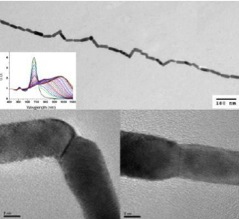 help
help
Home > Research teams > Nanothermique
Nanophotonics and Ultrarapid nanothermique: Recent results
Welding of gold nanorods
Thanks to the interaction between surfactant ligands stabilizing gold nanorods (NRs) asprepared in solution and a statistical block co-polymer, we have achievedtogether with chemists the self-assembling of NRs and their end-to-end welding,resulting in the formation of nanowores several micrometers long and about 10nm thick (Fig. 1). The self-assembling process has been monitored by real-timeoptical spectroscopy. This nanoscale welding technique opens promising outlooksfor photovoltaics and nanoelectronics.

Thanks to the interaction between surfactant ligands stabilizing gold nanorods (NRs) asprepared in solution and a statistical block co-polymer, we have achievedtogether with chemists the self-assembling of NRs and their end-to-end welding,resulting in the formation of nanowores several micrometers long and about 10nm thick (Fig. 1). The self-assembling process has been monitored by real-timeoptical spectroscopy. This nanoscale welding technique opens promising outlooksfor photovoltaics and nanoelectronics.
Figure 1. Conventional (top) and high-resolution (bottom) transmission electron microscopy images of obtained bycold chemical welding. The inset exhibits the optical monitoring of theself-assembling. Coll. LPS (Orsay) and SIMM (Paris).
Ultrafast optical modulation by plasmonic-photonic coupling
After having demonstratingtheoretically the possible amplification of the ultrafast transient opticalresponse of metal nanoparticles thanks to the coupling of their localized plasmonand a mode of a photonic cavity (Fig. 2), we have obtained experimental resultsconfirming the relevance of our approach. The samples elaborated by laserablation in the group of J. Gonzalo in the Instituto de Optica (CSIS,Madrid, Spain) consist of a nanocomposite thin film processed between twomultilayer dielectric mirrors (23 layers). The transient response, measured atLPQM-ECP over ultrashort time scales, exhibits a 40-fold magnification relativeto the one of a bare nanocomposite film.
Ultrafast optical modulation by plasmonic-photonic coupling
After having demonstratingtheoretically the possible amplification of the ultrafast transient opticalresponse of metal nanoparticles thanks to the coupling of their localized plasmonand a mode of a photonic cavity (Fig. 2), we have obtained experimental resultsconfirming the relevance of our approach. The samples elaborated by laserablation in the group of J. Gonzalo in the Instituto de Optica (CSIS,Madrid, Spain) consist of a nanocomposite thin film processed between twomultilayer dielectric mirrors (23 layers). The transient response, measured atLPQM-ECP over ultrashort time scales, exhibits a 40-fold magnification relativeto the one of a bare nanocomposite film.
Figure 2. Multilayer device consisting of gold nanoparticles processed within a 1D photonic cavity(left). Ultrafast modulation of the cavity mode induced by the absorptionof an ultrashort light pulse (right).
Near-field and far-field coupling inthe optical response of 2D gold nanoparticle arrays
We have published results concerning the optical response of 2D arraysof organized gold nanoparticles in which near- and far-field electromagneticcouplings may play a significant role. This kind of nanodevice can be used forinstance for realizing ultrasensitive biochemical sensors. The measurements inthe stationary regime have been carried out with partnership with the Institutd'Électronique Fondamentale (CNRS-Université Paris Sud) on sampleselaborated by electron-beam lithography at the Laboratoire de Photonique etde Nanostructures (CNRS, Marcoussis). Our numerical simulations based onthe discrete dipole approximation (DDA) agree very well with the experimentalresults (Fig. 3) and allows us to understand the role of electromagneticcoupling, near-field retardation effects, as well as dissipative and radiativedamping.
Figure 3. (a) Characteristics of the localized plasmon resonance(amplitude, wavelength and spectral width) as a function of the distancebetween chains of 2D-organized gold nanoparticles. Calculation results(discrete dipole approximation) and optical measurement results depending onthe incident field polarization. Coll. LPN (Marcoussis) et IEF (Orsay). (b) Simulated topography of the electromagnetic fieldin such a 2D array of gold nanoparticles.
Thermo-optical response of silver nanoparticles
In partnership with colleaguesfrom Iran, we have modelled the thermo-optical response of silver nanoparticles.We have shown that this response is mainly contributed by, either interband, orintraband electron transitions, depending on the spectral domain. The effect ofthe local electromagnetic field enhancement at plasmon resonance has also beendemonstrated.


